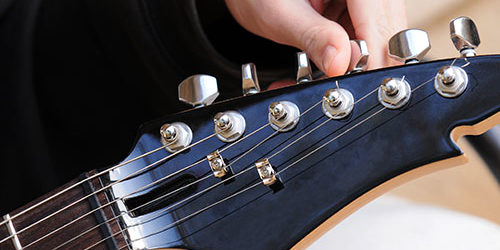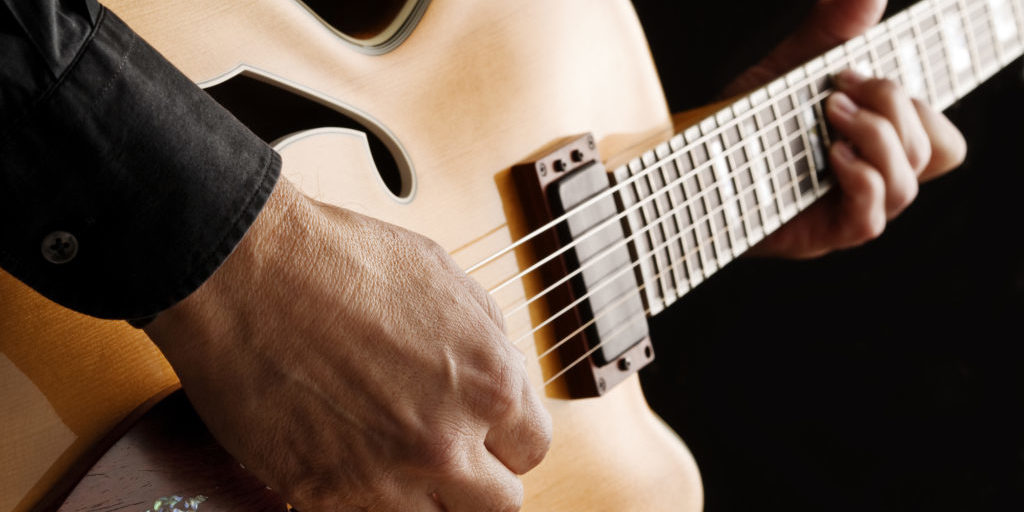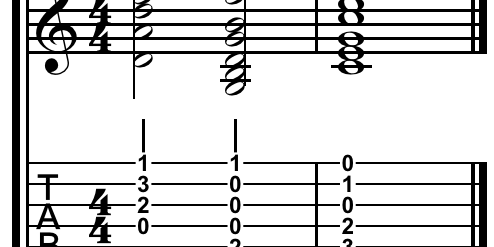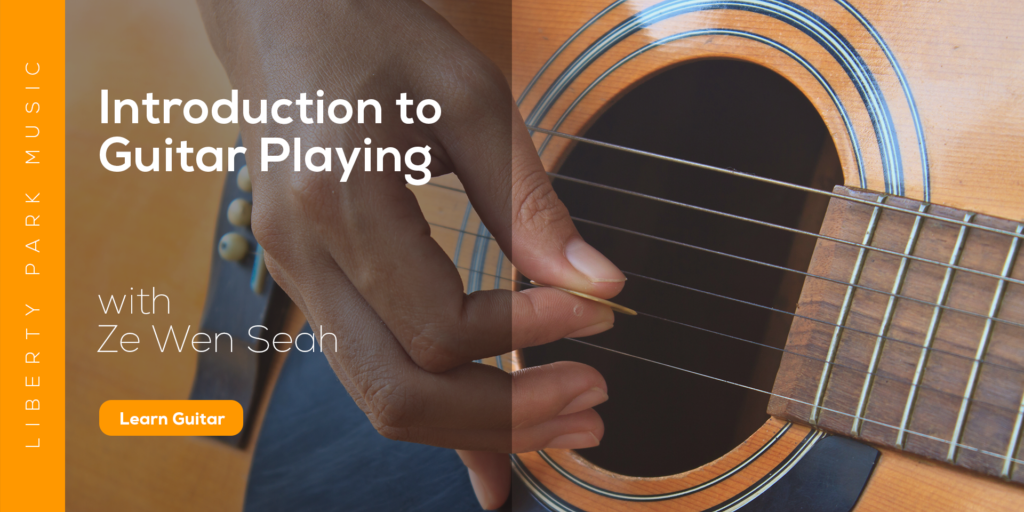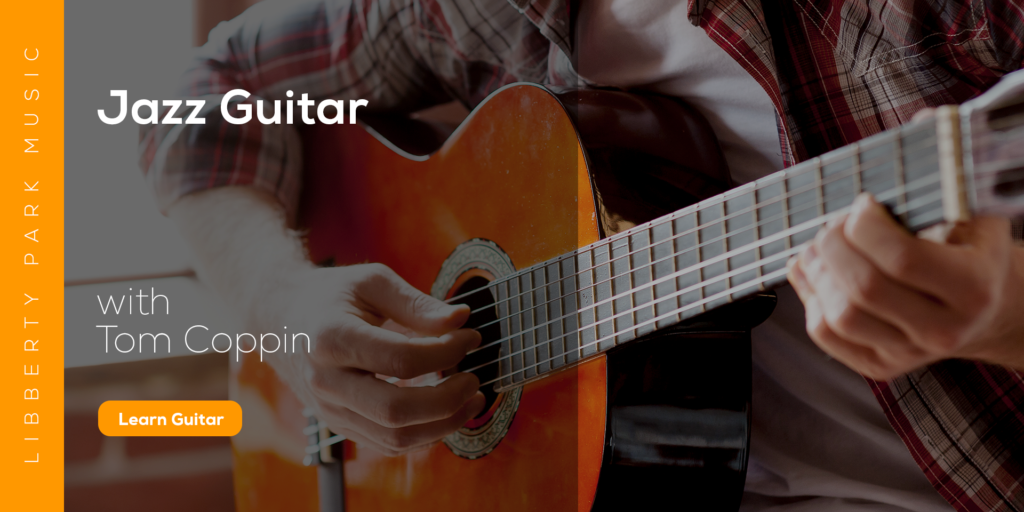
Chords are something we deal with everyday in music. Written down on a page, they can be as simple as just ‘A,’ or a completely terrifying ‘Amaj7#11b9’! By discussing the 7th chord, we start our journey into understanding the nature of extended chords, what they imply, and why they are not as terrifying as we may have thought. Delving further into chords gives us a much broader understanding of harmony in not just jazz, but all areas of music. So, whether you are playing classical, rock, jazz or even musical theatre, you will be able to apply this knowledge of harmony with great results. This lesson introduces the first chord ‘extension,’ which is the 7th, allowing us to play 7th chords such as the minor 7, major 7, and Dominant 7.
What are extensions? And what is the 7th?
A triad, a chord with three notes, is derived from a scale. For example in the key of C, the tonic triad is C major.
As discussed in previous articles, this triad is created by stacking intervals of a 3rd taken from the scale, in this case the C-major scale. If we want to take this tonic triad and add extensions to it, we would continue stacking thirds on top of it. We can even do this until we actually have a chord made up of all the notes in the C major scale (C-E-G-B-D-F-A-C)!
As we know already, the tonic triad is made up of the tonic (1), 3rd, and 5th notes of the scale. If we add just one extension, so another 3rd interval, we get the 7th! By doing this we have a 4-note chord 1, 3, 5, and 7.
As we know from the previous articles, the quality of the intervals (minor 3rds or major 3rds) is determined from the scale we use, for the 7th this determines whether it is a flat 7 (C-Bb, in Classical music theory, this is called a minor 7th interval) or a natural 7(C-B, also referred to as a major 7th interval in Classical music theory).
We call the C-B 7th natural because it is naturally part of the C scale. By flattening this interval, it gives us a flat 7 because Bb is not in the C major scale.
Types of 7th chords
For this explanation, let's look back at our ii V I progression in the key of C. By now you probably remember this is Dm, G, and C. These chords are all derived from the key (scale) of C major and the shape of intervals in the scale determines the quality of each chord (major or minor). Now let's add a 7th to each one by stacking another third on the triads we have learned in the previous article.
1 3 5 7
C Major 7 = C E G B
D Minor 7 = D F A C
G Dominant 7 = G B D F
You may have noticed that we now have three different chords, Major 7, Minor 7, and Dominant 7. These are the three main 7th chords we will look at. The two factors that determine these chord types is the intervals and the combination of minor thirds and major thirds, so how we construct them looks like this:
Major triad + Major 3rd (nat7) = Major 7 chord (M7)
Minor triad + Minor 3rd (b7) = Minor 7 chord (m7)
Major triad + Minor 3rd (b7) = Dominant 7 chord (7)
These three chords are the most important chords in jazz, making up most progressions you will come across, particularly as nearly all jazz music will be using 7th chords. When writing or reading these chords in sheet music or on a jazz chart, they are specified with different short hands. The major 7th is written often as a capital M with a 7 (CM7), but can be written as Cmaj7, or as commonly seen in jazz, with a small triangle C^7. Minor 7 chords are usually written as a lowercase Dm7, Dmin7, or a dash D-7. Dominant chords are always written as just 7, so G dominant 7 will be written as G7.
The Shapes
Adding the 7th doesn't mean relearning a bunch of new chords and arpeggios from scratch. As we now know, it is simply an additional note added to the triad, so compare these to there triad forms you already know and see what small differences there are. The chord shapes will be modified to include the 7th and the arpeggios will simply contain an extra note.
Practice playing the ii V I progression in C major using 7th chords.
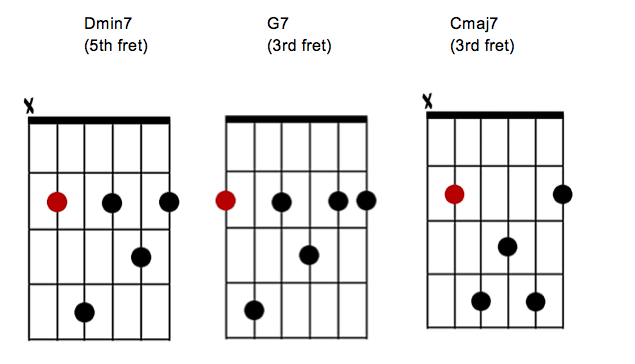
Now in the key of G major using the Minor 7 shape off the E string and Dominant 7 off the A string.
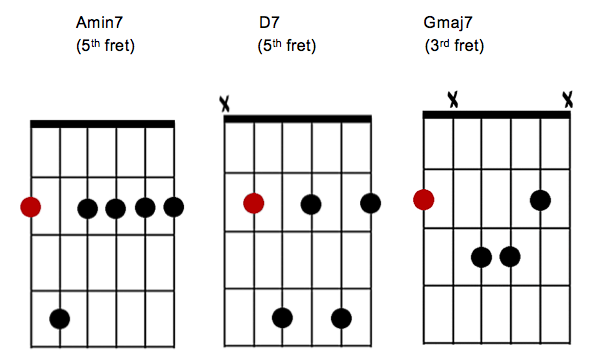
Learn with LPM
Using 7th arpeggios to improvise
Adding the 7th actually makes connecting the arpeggios quite a bit easier as we have an extra note to work with. Focusing on the ii V I progression, the arpeggios will look like this:

The following examples show three ways of connecting the arpeggios through the progression using straight 8th notes with no rhythmic variations.

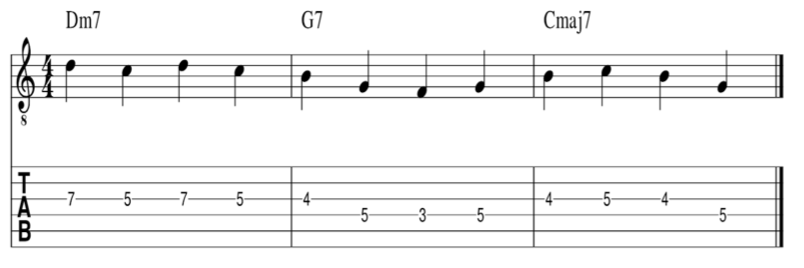
Play these with a metronome, starting slowly, and developing an even sound as you play through using alternate picking.
Outlining the I iv ii V Progression
For the I iv ii V progression we will follow the same concept by using the arpeggios to flow evenly through the chord changes. C major 7, A minor 7, D minor 7, and G Dominant 7 will be our 4 chords. Take each arpeggio and play through the progression and mix up the starting notes. The notation below shows the arpeggios being played through the progression in an economical fashion, linking them with minimal interval jumps. This makes the line flow better and sound more natural.
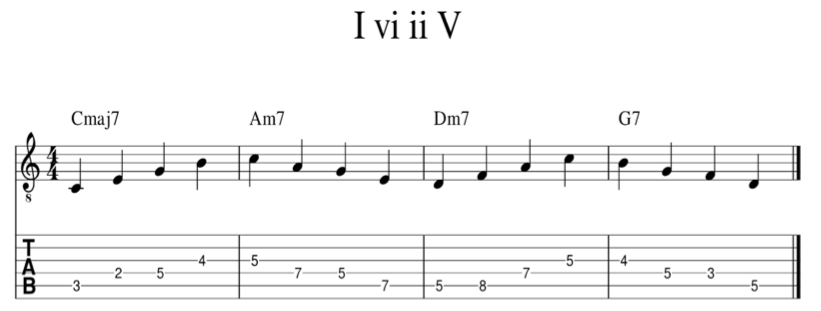
Chromatic passing notes
One of the most common sounds that is identifiably ‘jazz’ is the use of chromaticism. Chromaticism is the use of notes from the chromatic scale (all twelve notes: C, C#, D, D#, E etc.). When we talk about chromatic passing notes, it refers to a note that is used in passing that may not be part of the scale. An example of this would be when I play the notes C - D - E. this is a normal line using the notes of they scale, but to add a chromatic passing note, I can put a D# in between the D and E. This leads into the E nicely and creates a jazzy sound.
This applies to the arpeggios like this, you can use a chromatic passing note to approach any note in the arpeggio. This works particularly well when connecting arpeggios through progressions as we can create smooth lines that flow well without too many jumps.
Important to note: when using chromatic passing notes, always try to have them on the off-beats and the arpeggio notes on the downbeat. The following diagram shows the off-beats and downbeat and how the passing notes lead into each of the notes of the arpeggio.

This is important as the chromatic passing notes are not strong and they sound wrong. When they are played on the off-beats (indicated by a ^) they work as a lead into the ‘right’ note. When they are played on the downbeat, they sound wrong because the downbeat is stronger to the ear.
Conclusion
Once you have an understanding of how these shapes are used to outline each chord, you can start creating your own lines. Start simple and explore different ways of connecting them and listen out for them when transcribing or listening to your favourite musicians, this is quite an advanced concept so it is not necessary to start practicing, but to start thinking about it will open up your ear and you can see where learning the arpeggios is leading.
The seventh is an incredibly important aspect of jazz and music in general. It defines the harmony of most jazz repertoire and is a key part of improvisation. From here, the basis of jazz harmony is almost complete. The chords in this article will give you access to most of the repertoire and help in every other genre of music you may be interested in. Practice the chords with the arpeggios to help understand how they relate and sound together. The next step we will look at is to see how this is used through the improvised lines of great jazz players and by learning how to use it over a well known jazz standard.
More About the Teacher
Rowan Pattison is an Australian jazz and contemporary guitarist. His resumé boasts artists such as American singer Bobby Arvon (Happy Days), Broadway star Michelle Murlin, American Idol finalist Lou Gazzara, Marcus Terrel from America’s Got Talent, Vegas Trumpet prodigy Greg Bohnam and American Comedian James Stevens III, who is featured regularly on The Tonight Show and Comedy Central. Now based in Melbourne, Rowan has just lead his own trio concert Impressionism of Bill Evans on a tour of Europe playing concerts in Kyiv, Lviv, Krakow and Paris. Rowan's guitar courses with Liberty Park Music include the Introduction to Jazz Improvisation and Introduction to Solo Guitar.


